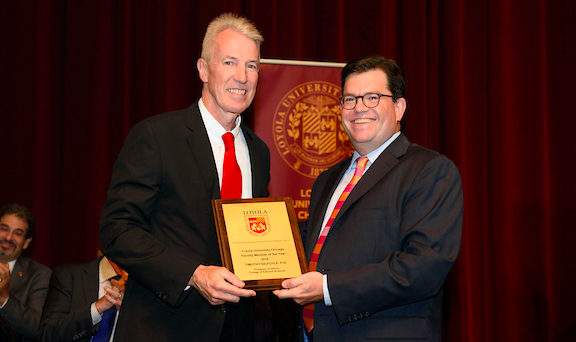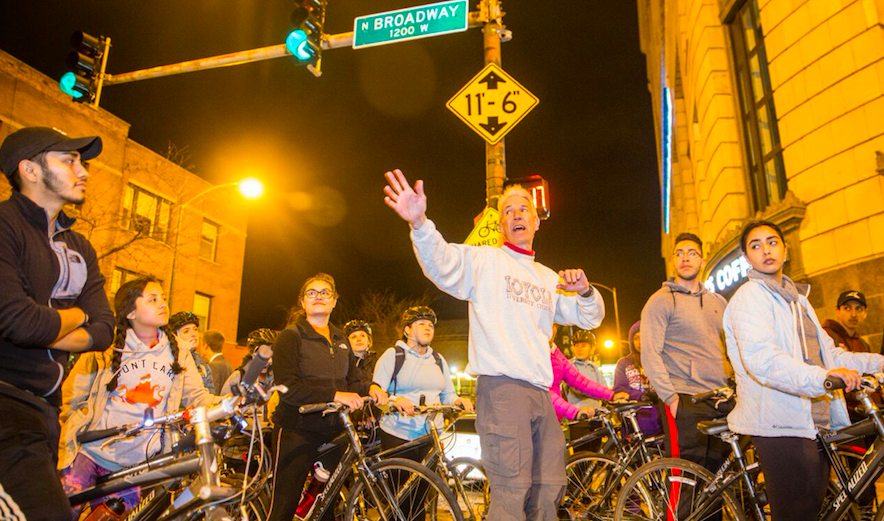archive
History Department Professor Timothy Gilfoyle Receives Loyola’s 2018 Faculty Member of the Year Award


The History Department is proud to share that, at this year’s Faculty Convocation, our own Dr. Timothy Gilfoyle was named Loyola’s 2018 Faculty Member of the Year. With this award, Professor Gilfoyle joins the ranks of previous History Department Faculty Members of the Year, including Doctors Anthony Cardoza (2007), Theodore Karamanski (2003), Joseph A. Gagliano (1996), William R. Trimble (1979), and Paul S. Lietz (1973). “As a member of the History Department,” said Dr. Gilfoyle in his remarks, “I have had the chance of working with some of the best historians in literally the world. I’m blessed to be in a department whose members have written more than 50 books during the past 20 years. More importantly, many of them are among my closest friends.”
Dr. Gilfoyle (Ph.D. (1987), B.A. (1979), Columbia University) is a professor and former chair of the History Department, where he teaches a number of perennially popular courses in American urban and social history. His research has focused on the development and evolution of various nineteenth-century urban underworld subcultures and informal economies.
After being named the 2018 Faculty Member of the Year, Dr. Gilfoyle caught up with Media Assistant Alex Gradwohl about his teaching philosophy, favorite classes, and well-known Midnight Bike Rides.
Congratulations on being named the 2018 Faculty Member of the Year! How would you describe yourself as a faculty member and teacher?
A faculty member has responsibilities to three communities: fellow scholars, Loyola colleagues, and students. As a professional historian for more than 30 years, opportunities to serve on editorial boards, national fellowship committees, nonprofit historical societies, scholarly organizations and other institutions related to public history and the humanities have enabled me to make contributions to the larger academic community and the general public.
Senior faculty have an obligation to mentor their younger peers by reading and editing their manuscripts, observe and advise them in the classroom, relieve them of service duties, and help them negotiate the delicate and confusing balance between professional and personal responsibilities. Older faculty mentored me in the same way when I arrived at Loyola; now it’s my turn.
Students, however, deserve the greatest attention and responsibility. I have multiple goals as a historian: to provide students with an intellectual framework with which they can better understand the world in which they live, to comprehend the confusion that surrounds them, to immerse them in complexity of the past, to foster empathy in worlds foreign to them by the passage of time. “Without a vivid link to the past,” Jason Epstein once wrote, “the present is chaos and the future unreadable.”
But this is easier said than done. The best history pedagogy integrates and intersects research, teaching and public engagement. During my 29 years at Loyola, I have regularly incorporated my own research, writing, and publication experiences with students both in and out of the classroom. Writing history honed my skills not only as an author but equally as a teacher, and ultimately to the benefit of my students. These experiences and my growth as a published and professional historian inevitably informed and improved my skills in the classroom.
What do you enjoy most about teaching? What are your favorite subjects to cover with your students?
The rewards of teaching are rarely immediate, especially if teachers are pushing their students to read more than they are accustomed, or encouraging them to think in new ways about old subjects. Over the years I have found the positive feedback I receive in student evaluations to be the most enjoyable part, especially when a student recognizes what was the purpose of the class and that all the work was worthwhile.
I was trained as an urban historian, but my favorite class is the American survey, either in the form of HIST 103: American Pluralism or HIST 211/212: U.S. History before and after the Civil War. In these classes, I enjoy teaching the most important and controversial subjects in American history. So many topics are possible that it is impossible to teach all of them, so I focus on what I consider to be the “hit parade” of American history, with many subjects relevant to the contemporary world in which we live.
At Loyola, you’re well known for your semi-annual Midnight Bike Ride and frequent tours with your classes. How did you get started with the Midnight Bike Ride? Do you have any favorite memories from the Ride over the years?
The first Midnight Bike Ride I offered was in September 1989, approximately two-and-a-half months after I moved to Chicago from New York City. My undergraduate advisor and dissertation supervisor at Columbia University, Prof. Kenneth T. Jackson, offered such a bike ride with his urban history classes, in which I participated when I was in college. As a graduate student and later as a professor at Sarah Lawrence and Barnard Colleges, I worked with him on organizing and mapping out the nighttime rides. The events were among the highlights of my years living in New York. So when I landed in Chicago, I knew the city shared many of the same historical themes as New York: similar immigration patterns, contentious race relations, tall buildings, historically-important architecture, world-renowned cultural institutions, etc. I just needed to learn new “facts” about those different themes, which I did shortly after arriving because it forced me to learn about my new home quickly.
My favorite Bike Ride stop no longer exists: The A. Finkl & Sons steel mill in the Lincoln Park neighborhood along the Chicago River and Cortland Street. The main mill operated along a roughly 28-acre lot along the eastern portion of the river for more than 112 years before being demolished in 2014. At that time, it was the oldest and last steel mill in Chicago. My friend Joe Curci worked at Finkl and always arranged a tour of the mill for the Midnight Riders. It has been hard to find a replacement for Finkl on the Midnight Bike Ride.

